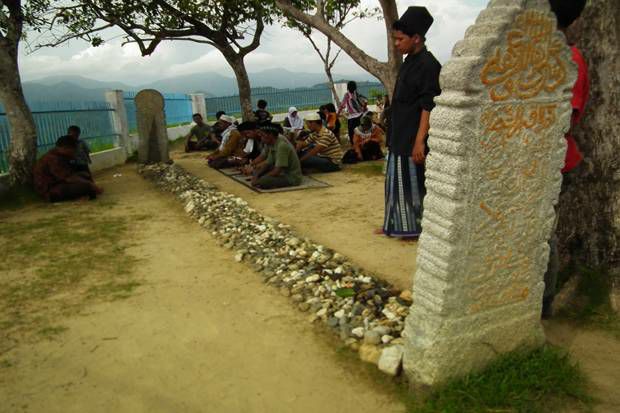The historicity of the Islamic religion is always interesting to observe, especially the stories of its propagators. In addition to the Prophet Muhammad, companions also played a role in the spread of Islam. The spread of Islam is not only focused on the Arab region. Islam is also spread throughout the world, including Indonesia.
Early evidence of the entry of Islam into Indonesia is supported by the discovery of Islamic tombs in the Sumatra area. For Example, the tomb of Mahligai, located on the hill of Central Tapanuli, North Sumatra; Papan Tinggi grave in Barus, North Sumatra; the tomb of Tuhar Amisuri, Hasang Village, Barus District, North Sumatra; and the tomb of Meurah Silu in Aceh.

All of the Islamic tombs are ancient, and out of those ancient tombs, the tomb of Syekh Mahmud in the Papan Tinggi Tomb complex is suspected of the tomb of the Prophet’s companions. However, in this regard, not many people know about it.
Syekh Papan Tinggi, known as Syekh Mahmud, was included in the group of the first propagator of Islam in the archipelago. He was a merchant and preacher from Yemen and was sent to Asia during the caliph Umar bin Khattab. From a Youtube channel (FSRMM Channel), it is stated that Sheikh Mahmud is the son of Abdullah bin Mas’ud. Sheikh Mahmud died in 44 H during the reign of Muawiyyah bin Abi Sufyan.
Barus as the Gateway to Islam
Based on the circulating literature, Barus is an old city located in Central Tapanuli Regency, North Sumatra, which is the gateway for the entry of Islam into Indonesia. Therefore, if Walisongo carried out the spread of Islam in Java in the 14th century AD, Islam in Barus has existed since the early 7th century.
Syekh Mahmud is estimated to have lived in the 7th century AD. At that time, Barus, directly opposite the Indian Ocean, became a stopover centre for international shipping. Barus is known to the world as a lime-producing area. Merchants from Arabia, Yemen, Jordan, the Indies, and Persia did a lot of spice and camphor business in the area. Barus was also the first place the scholars of the caliphate stepped on to spread Islam’s teachings. Therefore, it is not surprising that there are Islamic tombs in Barus. In addition to the tomb of Syekh Mahmud, in the Papan Tinggi Tomb, on a hill in the Barus area, in the village of Dakka, more than 200 tombs were found.
The location of the Barus area with the city of Medan is about 290 kilometres. The journey from Medan to Barus takes about 7 hours by land. Meanwhile, it takes 2 hours from Sibolga City. Barus holds a lot of history and is a religious tourist attraction.
Information about the old city is still minimal because people do not know Barus in depth. However, as the early area of Islamic civilization in the archipelago, Barus kept many historical objects such as currencies, jewellery, inscriptions, etc. Moreover, the tombs of the bearers of Islamic teachings in the archipelago in the 7th century AD are no less important. Barus’s tombs include Sheikh Mahmud, Sheikh Rukunuddin, Sheikh Mahdun, Sheikh Ibrahim Shah, Sheikh Badan Batu, and the tomb of Mr Ambar.
Barus became a destination for merchants because it was famous for its forest products such as camphor, gold, and frankincense. In addition, through Hamzah Fansuri, Barus’ name was known as Pancur or in Arabic Fansur. Barus is an ancient city that has been famous since the 6th century AD in Asia, as Claude Guillot mentioned in his book Barus A Thousand Years Ago. Furthermore, President Joko Widodo, on Friday, March 24, 2017, determined that Barus was the zero point of the centre of Islamic civilization in the archipelago.
Syekh Mahmud’s Tomb as a Religious Tourism Object
The tomb of Sheikh Papan Tinggi is not only visited by Muslim tourists but also non-Muslims. The purpose of the tourists is for pilgrimage and vacation. The tomb is at an altitude of 200 meters above sea level and on a hill with a slope of 45 degrees.
To get to the tomb, the tourists have to climb stairs that are so high more than 200 meters and as many as 700 more steps. But, it doesn’t stop there, and tourists will be surprised because the tomb size is so long that it reaches more than 8 meters. While the tombstone measuring 1.5 meters, is white with ancient Arabic carvings.
The number of visitors who have come to the tomb of Syekh Mahmud since 1990 has made the residents of Pananggahan Village take the initiative to establish small businesses such as trading. This is done to help meet daily needs.
Pananggahan village is unique since most of the population are Protestant Christians, and only six people have embraced Islam. However, even so, the village looks peaceful, and even non-Muslim communities participate in developing the tourist attraction of Syekh Mahmud’s tomb.
The infrastructure facilities are located at Syekh Mahmud’s tomb, from the gate, parking lots, ticket purchases booth, community leaders’ houses, prayer rooms, trading locations, public bathrooms, ablution places, and stairs to the tomb. Circumstances around the tomb are still reasonably simple.
The government expects the community and tourists to make this tourist attraction more advanced with adequate facilities. This is because Sheikh Mahmud was the first person to spread Islam in the archipelago and was a friend of the Prophet. Hence, it is a high hope that his grave can become a national and world religious tourist destination.
Note: translated by editor from www.duniasantri.co/ziarah-makam-syekh-mahmud-sahabat-nabi-di-nusantara








